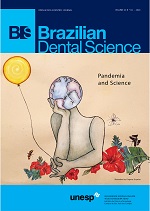Effect of immediate dentin sealing, bonding technique, and restorative material on the bond strength of indirect restorations
DOI:
https://doi.org/10.14295/bds.2020.v23i2.1923Resumo
Objective: The objective of this study was to evaluate the effect of immediate dentin sealing, bonding technique, and restorative material on the dentin bond strength of an indirect composite (Solidex) and a resin nanoceramic CAD/CAM block (LAVA Ultimate). Material and Methods: A total of 120 periodontally extracted human molar teeth were abraded horizontally and divided into two groups according to dentin sealing procedures (delayed dentin sealing [DDS] and immediate dentin sealing [IDS]). Next, all teeth were attached to a simulated pulpal pressure mechanism. The specimens were removed from the mechanism after a week. Teeth were subdivided into three groups based on the bonding technique and the type of cement used (Acid-etching + Single Bond Universal + RelyX Ultimate, Single Bond Universal + RelyX Ultimate, RelyX Unicem). Each subgroup was further divided into 2 subgroups according to the type of restorative material used (Solidex [n=10], Lava Ultimate CAD/CAM restorative material [n=10]).. Sixty cylindrical samples prepared using both the restorative materials were bonded to the tooth surface according to their group’s bonding procedures. All specimens were embedded in chemically cured acrylic resin for shear bond strength test. The shear bond strength (SBS) of the specimens was determined by a universal testing machine with a headspeed of 0.5 mm/min. Results: Three-way ANOVA, independent-sample t test and post hoc Tukey comparison tests (?=0.05) were performed on all data. There were significant differences between the groups. It was found that IDS process significantly increased bond strength in all groups. When dentin bond strengths of tested luting cements were compared, the highest bond strength values were recorded in groups in which the specimens were luted with RelyX Ultimate cement using etch-and-rinse technique. The lowest bond strength values were obtained from groups that used RelyX Unicem as the luting cement. Conclusions: IDS improves bond strength of indirect restorations. Moreover, bonding techniques may have critical effects on the dentin bond strength of indirect restorative materials. The cements’ specific affinity levels to both restorative materials and dentin could be considered as the reason of the situation.
KEYWORDS
IDS; Luting cement; Shear bond strength; Resin nanoceramic; CAD/CAM.
Downloads
Downloads
Arquivos adicionais
Publicado
Como Citar
Edição
Seção
Licença
TRANSFERÊNCIA DE DIREITOS AUTORAIS E DECLARAÇÃO DE RESPONSABILIDADE
Toda a propriedade de direitos autorais do artigo "____________________________________________________________________" é transferido do autor(es) para a CIÊNCIA ODONTOLÓGICA BRASILEIRA, no caso do trabalho ser publicado. O artigo não foi publicado em outro lugar e não foi submetido simultaneamente para publicação em outra revista.
Vimos por meio deste, atestar que trabalho é original e não apresenta dados manipulados, fraude ou plágio. Fizemos contribuição científica significativa para o estudo e estamos cientes dos dados apresentados e de acordo com a versão final do artigo. Assumimos total responsabilidade pelos aspectos éticos do estudo.
Este texto deve ser impresso e assinado por todos os autores. A versão digitalizada deverá ser apresentada como arquivo suplementar durante o processo de submissão.




























